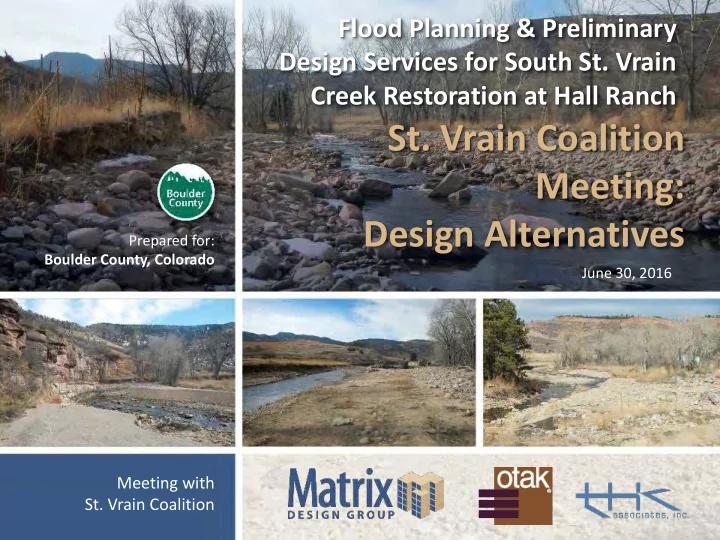

Flood Planning & Preliminary Design Services for South St. Vrain Creek Restoration at Hall Ranch St. Vrain Coalition Meeting: Design Alternatives Prepared for: Boulder County, Colorado June 30, 2016 Meeting with St. Vrain Coalition
I ntroduction Introduction § Purpose of meeting: Design Alternatives Project website § www.BoulderCountyOpenSpace.org/ssv
Matrix Team
Project Area
Project Schedule Design schedule § Notice to Proceed: May 2016 § Alternatives Compiled: June 2016 § Preferred Alternative: July 2016 § 30% Draft Design: August 2016 § Final Deliverable: September 2016
W ork to Date Riparian and Wetland Assessment Aquatics and Terrestrial Concerns Sediment Sampling Homeowner Meetings Existing/Ongoing Project Coordination
Project Goals Statem ent Provide a conceptual design for the entire South Saint Vrain Creek project area that restores and improves the channel and surrounding floodplain areas to a safe, natural, resilient, functioning, and ecologically rich habitat. This project will use qualitative research, quantitative data, and community input to inform resilient design that shall utilize natural system principles and onsite materials to expedite recovery from the 2013 floods and set up for better performance in future flood events. Components to meet goals include incorporating natural channel diversity and character, re-establishing floodplain benches for lateral connectivity, reducing longitudinal connectivity constraints, improving flow conveyance and sediment transport to maintain environmental values, promote naturally functioning stream processes, protect public and private infrastructure, improve public safety, repair unstable erosion scars in high-risk areas, and revegetate denuded areas.
Decision Making Process
Prioritization Criteria
Alternatives: I ssue & Reach Based Alternatives and Strategies: § Floodplain Connectivity § Channel Complexity § Revegetation § Infrastructure Protection Master Plan: The purpose of this alternative is to implement a channel alignment that will optimize the interaction with completed, ongoing, and funded projects while being sensitive to the constraints presented by the presence of numerous private residences throughout this river corridor. The implementation of this alternative will expedite the maturation of this reach by re-establishing a natural channel, repairing erosion scars, re-establishing floodplain benches, building point-bars and excavating pools, revegetating denuded areas, and stabilizing channel banks.
Alternative: Floodplain Connectivity Floodplain connectivity involves activating the floodplain at frequent intervals to enable critical floodplain functions, including: § Sediment storage § Reduction of erosive forces in main channel § Nutrient transfer § Healthy riparian/wetland ecosystem Strategies to establish floodplain connectivity include: § Activating overflow channels § Incorporating channel/floodplain benching (sediment removal)
Alternative: Floodplain Connectivity
Alternative: Channel Com plexity Channel complexity refers to channel features that contribute to geomorphically effective bedforms, as well as habitat quality and diversity § Low Flow Channel § Pools, riffles, steps § Bars (point, lateral, mid-channel) § Large woody material (bank protection/habitat enhancement) § Roughened channels/boulder clusters
Alternative: Channel Com plexity
Alternative: Channel Com plexity
Alternative: Revegetation Revegetation will provide the framework for increased ecosystem function and aesthetic appeal along the corridor. Our team will: § Protect and preserve existing stands of vegetation § Incorporate bioengineering measures to increase habitat maturation and resiliency § Plant a diverse palette of native plant species § Willow clusters § Cottonwood galleries § Wetlands (perennials) § Riparian benches (perennials and woody plants) § Upland meadows (grasses, wildflowers and trees)
Alternative: Revegetation Cotton Wood Gallery Wetland/Riparian Bench Grassland Meadow 100 Year Floodplain Shrub/ Cottonwood Riparian Woodlands/ Open Water Riparian/ Fringe Cottonwood Shrub/ Grassland Gallery Fringe Wetlands Channel Wetlands Gallery Grassland Residual Third Second Floodplain Floodplain First Second Third Terrace Terrace Terrace Bench Bench Terrace Terrace Terrace
Alternative: I nfrastructure Infrastructure: Roads, Bridges, Houses, Ditches Bank Stabilization § Bioengineering § Buried Rootwads Offset Buried Natural/Structural Aspects § Buried Riprap Revetment § Buried Boulders § Structural Walls Channel Alignment: In-depth Analysis Required § Slope, Sinuosity, Wavelength, Belt Width Detention Cost
Alternative: I nfrastructure Protection Root Wad Stabilization Utility Armoring Boulder Toe Protection Vegetated Geogrid
Em ergency W atershed Protection ( EW P) Colorado Emergency Watershed Protection (EWP) Program, Phase II
Em ergency W atershed Protection ( EW P) Purpose : Implement emergency recovery measures to protect life and property in watersheds impaired by a natural disaster Funding : $63.2 mil. total/ $47.4 mil. federal State Sponsor : Colorado Water Conservation Board Local Sponsors : Counties, cities/towns, watershed coalitions, others Timeline : April 1, 2018 technical assistance agreement ends 21 Lefthand Watershed Oversight Group Public Meeting 4/11/2016
EW P: Benefits Landow ners Safety - Purpose of projects: protect life safety and property from future flooding and erosion No Cost to Landowner - Projects funded through federal, state, and local sponsors without capital cost to landowners, can opt out at any time before final design Holistic Approach - Opportunity to: § Design projects as a system and minimize impacts to downstream properties § Address some reach-wide water and sediment management issues Stream and Habitat Health - Improve overall ecological health and resiliency of your property Opportunities for Multiple Benefits: § Stabilize stream channels § Reconnect floodplains with streams § Manage sediment § Reduce hazards and improve flood conveyance § Improve habitat § Enhance recreational opportunities 22 Lefthand Watershed Oversight Group Public Meeting 4/11/2016
EW P: Benefits Landow ners Key Topics for Collaboration and Agreement Channel Location Vegetation Landscape Planting Features 23 Lefthand Watershed Oversight Group Public Meeting 4/11/2016
Preferred Alternative Combination of Alternatives Decision Matrix Engineering/Science Based Judgements Consensus and Buyoff from Stakeholders Understanding Construction Project Goals and Funding
Site Visit w ith Stakeholders Opportunity to walk sites with team to understand alternatives and preferred alternative Week of July 18 th
W hat’s Next? Evaluate Alternatives with Decision Making Matrix Prioritize Alternatives Sediment Transport Analysis Geomorphic Site Survey Draft 30% Designs Final 30% Designs
Recommend
More recommend